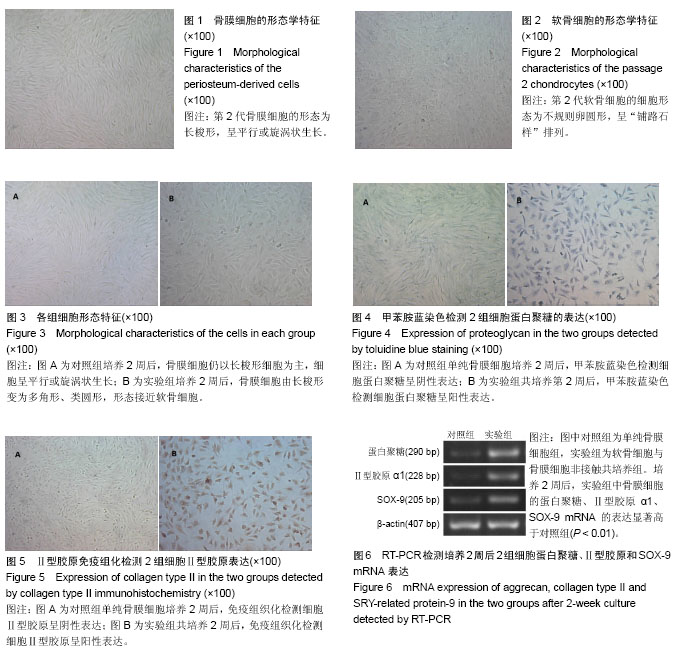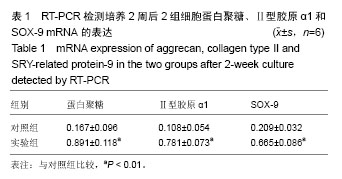| [1] Mithoefer K. Complex articular cartilage restoration. Sports Med Arthrosc. 2013;21(1): 31-37. [2] Hoyer B, Bernhardt A, Lode A, et al. Jellyfish collagen scaffolds for cartilage tissue engineering. Acta Biomater. 2014; 10(2): 883-892.[3] Danisovic L, Varga I, Zamborsky R, et al. The tissue engineering of articular cartilage: cells, scaffolds and stimulating factors. Exp Biol Med (Maywood). 2012;237(1): 10-17.[4] Yamasaki S, Mera H, Itokazu M, et al. Cartilage Repair With Autologous Bone Marrow Mesenchymal Stem Cell Transplantation: Review of Preclinical and Clinical Studies. Cartilage. 2014;5(4):196-202. [5] Li C, Wei G, Gu Q, et al. Donor Age and Cell Passage Affect Osteogenic Ability of Rat Bone Marrow Mesenchymal Stem Cells. Cell Biochem Biophys. 2015;72(2): 543-549. [6] Choi YS, Noh SE, Lim SM, et al. Multipotency and growth characteristic of periosteum-derived progenitor cells for chondrogenic, osteogenic, and adipogenic differentiation. Biotechnol Lett. 2008;30(4): 593-601.[7] Jansen EJ, Emans PJ, Guldemond NA, et al. Human periosteum-derived cells from elderly patients as a source for cartilage tissue engineering? J Tissue Eng Regen Med. 2008; 2(6): 331-339.[8] 吕晶,柯杰,王琳,等.与软骨细胞共培养和条件培养液诱导骨髓间充质干细胞向软骨细胞分化的比较[J].中国组织工程研究与临床康复,2011,15(19):3421-3426.[9] Park YB, Seo S, Kim JA, et al. Effect of chondrocyte-derived early extracellular matrix on chondrogenesis of placenta-derived mesenchymal stem cells. Biomed Mater. 2015;10(3): 035014.[10] 田峰,崔学生,张帅,等.改良分步消化法培养原代软骨细胞[J].中国组织工程研究与临床康复,2011,15(20):3633-3635.[11] 张峻玮,陆海涛,袁峰,等.兔骨膜细胞分离培养的方法改进[J].中国组织工程研究,2016,20(24):3523-3528.[12] Baldwin JG, Wagner F, Martine LC, et al. Periosteum tissue engineering in an orthotopic in vivo platform. Biomaterials. 2016;121:193-204.[13] Bolander J, Ji W, Geris L, et al. The combined mechanism of bone morphogenetic protein- and calcium phosphate-induced skeletal tissue formation by human periosteum derived cells. Eur Cell Mater. 2016;31:11-25.[14] Ito R, Matsumiya T, Kon T, et al. Periosteum-derived cells respond to mechanical stretch and activate Wnt and BMP signaling pathways. Biomed Res. 2014;35(1): 69-79.[15] 贝抗胜,吴礼杨,孙庆文,等.人骨膜细胞生物学特性的实验研究[J].中华创伤骨科杂志,2011,13(12):1170-1174.[16] Chung JE, Park JH, Yun JW, et al. Cultured Human Periosteum-Derived Cells Can Differentiate into Osteoblasts in a Perioxisome Proliferator-Activated Receptor Gamma-Mediated Fashion via Bone Morphogenetic Protein signaling. Int J Med Sci. 2016;13(11): 806-818.[17] Kubo K, Att W, Yamada M, et al. Microtopography of titanium suppresses osteoblastic differentiation but enhances chondroblastic differentiation of rat femoral periosteum-derived cells. J Biomed Mater Res A. 2008;87(2): 380-391.[18] Wang WZ, Yao XD, Huang XJ, et al. Effects of TGF-beta1 and alginate on the differentiation of rabbit bone marrow-derived mesenchymal stem cells into a chondrocyte cell lineage. Exp Ther Med. 2015;10(3): 995-1002. [19] Frisch J, Rey-Rico A, Venkatesan JK, et al. rAAV-mediated overexpression of sox9, TGF-beta and IGF-I in minipig bone marrow aspirates to enhance the chondrogenic processes for cartilage repair. Gene Ther. 2016;23(3): 247-255.[20] 贝抗胜,吴礼杨,孙庆文,等.BMP4促进人骨膜来源细胞体外成软骨细胞分化[J].中华显微外科杂志,2013,36(5):469-474. [21] Dexheimer V, Gabler J, Bomans K, et al. Differential expression of TGF-beta superfamily members and role of Smad1/5/9-signalling in chondral versus endochondral chondrocyte differentiation. Sci Rep. 2016; 6:36655.[22] Cheng S, Aghajanian P, Pourteymoor S, et al. Prolyl Hydroxylase Domain-Containing Protein 2 (Phd2) Regulates Chondrocyte Differentiation and Secondary Ossification in Mice. Sci Rep. 2016;6:35748.[23] Gobbi A, Chaurasia S, Karnatzikos G, et al. Matrix-Induced Autologous Chondrocyte Implantation versus Multipotent Stem Cells for the Treatment of Large Patellofemoral Chondral Lesions: A Nonrandomized Prospective Trial. Cartilage. 2015; 6(2): 82-97.[24] Thitiset T, Damrongsakkul S, Bunaprasert T, et al. Development of collagen/demineralized bone powder scaffolds and periosteum-derived cells for bone tissue engineering application. Int J Mol Sci. 2013;14(1): 2056-2071.[25] Jayasuriya CT, Chen Y, Liu W, et al. The influence of tissue microenvironment on stem cell-based cartilage repair. Ann N Y Acad Sci. 2016;1383(1): 21-33.[26] Igarashi M, Sakamoto K, Nagaoka I. Effect of glucosamine on expression of type II collagen, matrix metalloproteinase and sirtuin genes in a human chondrocyte cell line. Int J Mol Med. 2017;39(2): 472-478.[27] Lu TJ, Chiu FY, Chiu HY, et al. Chondrogenic differentiation of mesenchymal stem cells in three-dimensional chitosan film culture. Cell Transplant. 2016;26(3):31-53.[28] David MS, Kelly E, Zoellner H. Opposite cytokine synthesis by fibroblasts in contact co-culture with osteosarcoma cells compared with transwell co-cultures. Cytokine. 2013;62(1): 48-51.[29] Noro D, Kurashige Y, Shudo K, et al. Effect of epithelial cells derived from periodontal ligament on osteoblast-like cells in a Transwell membrane coculture system. Arch Oral Biol. 2015;60(7):1007-1012. [30] Murdoch AD, Hardingham TE, Eyre DR, et al. The development of a mature collagen network in cartilage from human bone marrow stem cells in Transwell culture. Matrix Biol. 2016; 50:16-26. |
.jpg)


.jpg)